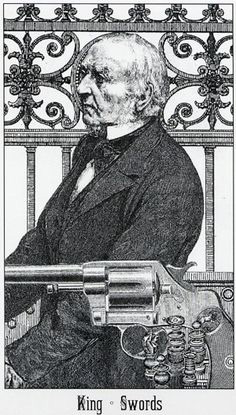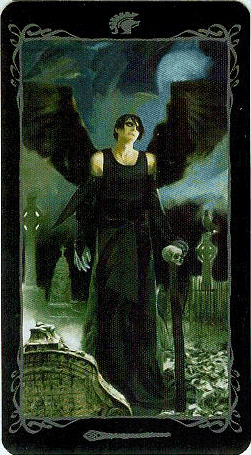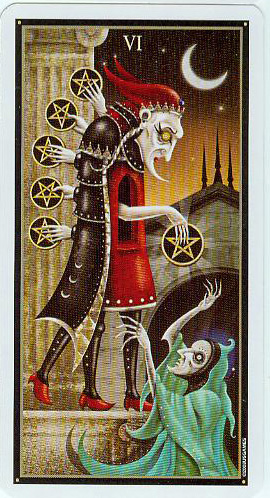Opening the Cellar Door: The Role of Tarot's Dark Archetypes
Posted by Jeannette Roth on Aug 19th 2018
Let me begin with a story.
Not long after I began my tarot retail career, I was exchanging emails with a customer who was preparing to buy a deck/book set called The Victoria Regina Tarot (now sadly out-of-print). Like customers who had previously purchased the deck, the potential buyer was enchanted by the authentic Victorian engravings used, and by the overall turn-of-the-century charm of the images.
However, just as we were about to finalize payment, the customer wrote again to cancel the order. It was nothing personal, she assured me – but she had just discovered the suit of swords had been transformed by the deck creators into the suit of "guns." Although she dearly loved the card imagery as a whole, she explained that she could not own or use any deck featuring such "horrid instruments of violence."
Since that experience, I've had the good fortune to meet, speak with, and correspond with many, many other tarot enthusiasts from around the world. And from time to time, I've encountered folks who have expressed variations of this same concern. Some examples:
"The 'Death' card in that deck is too scary."
"That 'Devil' card doesn't belong in a pagan deck! It's too negative."
"The creator of that deck was an evil and depraved person, and I've heard his cards give nasty readings." (Pop quiz for experienced tarotists: guess which deck most frequently elicits that particular comment?)
"That whole deck is just too… dark."
With so many different tarot decks available today, it's happy news that those who voice such objections to certain decks need not look far to find a suitable alternative. Certainly I have no reason to fault the customer who rejected the Victoria Regina deck for her decision. The way I see it, my job is to match customers with the best deck or decks for them, and selling the Victoria Regina deck to that particular client would clearly not have accomplished that goal. So… end of story, right?
Not really…
In… or Out?
I'm going to assume most of you reading this post would agree with me when I say the majority of people who buy a deck and make it past the "curious experimentation" phase eventually employ the cards as a tool for personal or spiritual discovery and growth. The process itself takes many forms, from readings to meditation to academic exploration of history and symbolism and more. But in the end, the objective is the same: to learn more about ourselves, and about what we have the potential to become.
Furthermore, I'm going to assume those of you who have done me the honor of reading some of my previous blogs on this website have gathered I would be among the last people to argue that the expression of tarot's archetypes should follow a particular rigid, narrow structure. I firmly believe that contemporary decks with a intensely "positive slant" – sometimes sardonically referred to as "fluffy bunny" decks within certain segments of the tarot community – have their place in the grand scheme of the "cosmic archetype archive."
And finally, I'd like to clearly state for the record that I do not presume to pass judgment on individuals who reject particular decks for their own use, based on the way they perceive the execution of the symbols and images. Simply because I personally don't find anything objectionable about using guns as a tarot suit doesn't mean I feel the need to condemn another for doing so.
With all that said, however, I must confess to feeling a bit uneasy regarding the movement that periodically arises within the tarot community, advocating the removal all "negativity" from tarot. In a less extreme but still related vein, there appear to be others who claim to accept the role of tarot's "bad" cards, yet at the same time tend to apologize for their presence rather than truly embracing them. From the reader who hesitates to impart unhappy news, to the meditator who fears to step into the "Tower" card or the "10 of Swords," to the symbologist who feels driven to explore and express only the "positive" dimensions of each archetype, we display an all-too-human tendency to deal with what is less than pleasant by shutting it out, editing it out, or out-and-out throwing it out.
Perhaps the real problem is that we never truly opened the door to let it all the way in.
What is Lurking in the Darkness?
Ask any tarotist if he or she believes ignoring the "bad stuff" in life is the key to making it all go away, and I suspect that few, if any, would argue that it is. Indeed, tarot is often promoted as a tool for working through pain and suffering. How could it serve such a purpose without cards to represent those experiences?
And yet, knowing this, we still shy away from the unpleasantness of certain cards. We know that others fear them, and in truth, we fear them ourselves. When we see bad news in the cards while reading for a querent, we look for ways to "soften the blow." When people whose only exposure to tarot has been through stereotypical and misleading presentations in the popular media criticize the cards as "superstition" or "evil," we may try to defend the discipline by presenting the "real" (i.e., non-threatening) meanings of those oft-sensationalized dark images. When we read for ourselves, we may characterize the presence of unsettling cards as "confusing" or "unclear," and begin to draw "clarifying" cards until we find something that can comfort us.
Such fears carry with them a price. I'm certainly not the first to say it, but it bears repeating nonetheless: when we shut out the darkness, the suffering, and the pain, we simultaneously close ourselves off to opportunities to be the best we can be. This, in a nutshell, is the role of the dark archetypes: to open the doors to our fears and force us to face them. Doing so gives us the chance to call upon those virtues and powers within ourselves for which we have no use or need under happier circumstances, and so would not see the light of day otherwise. To assume we cannot show courage, focus, resourcefulness, and compassion under adverse circumstances is to argue for our own limitations – and that is contrary to tarot's message. Tarot pushes us to move beyond our perceived limits – to know that they are not real, but rather, are of our own making. If we cannot believe that, if we do not believe that, then why bother continuing our tarot work? Happy affirmations can be found with much less effort by studying corporate inspirational posters and the contents of fortune cookies. But the seeker who desires to know genuine fulfillment must occasionally peer into the darkness; an overabundance of light, in the end, can blind.
Conclusion
Earlier in this column, I stated my willingness to embrace "fluffy bunny" tarots, and my reluctance to criticize people who express a dislike of the "negativity" of certain decks. If those comments seem to contrast with the opinions I subsequently expressed in the remainder of this article, consider this: I am not proposing that we "troll for trouble," and replace avoidance of the negative with the creation of it. There are times – perhaps more frequently occurring than not – when the solution to a problem is to seek out all the happiness and light we can possibly identify. And, as with positive imagery, the match between an individual and the dark archetypes used by a particular deck is subjective; some approaches to the dark images "work" better than others for a given person.
Indeed, my real point is to contrast healthy focus on the positive from an unhealthy evasion of the negative that seems to have more openly crept in as tarot attracts a wider base of students and practitioners. We must not fool ourselves into thinking that finding a "happy spin" and positive frame of mind alone will make all problems disappear. Nor should we deny ourselves the opportunity to express the nobler parts of ourselves that are more likely to be brought to the forefront through adversity. To frame the concept succinctly in metaphorical tarot terms: we must consider the possibility that on occasion, the "Death" card may really mean physical death, or that the "Devil" card may be speaking of genuine evil. As fearsome as such interpretations may be, we may find ourselves facing something infinitely more terrifying if we disregard their warnings.
Remember: all the cards, both light and dark, can open doors. And opening a door for another is always considered an act of kindness.




